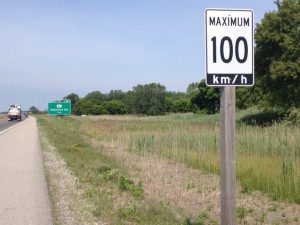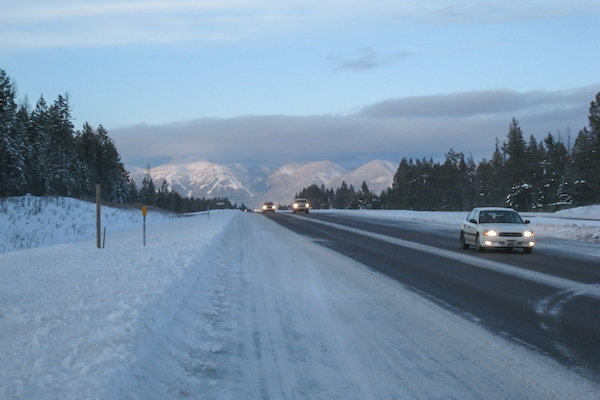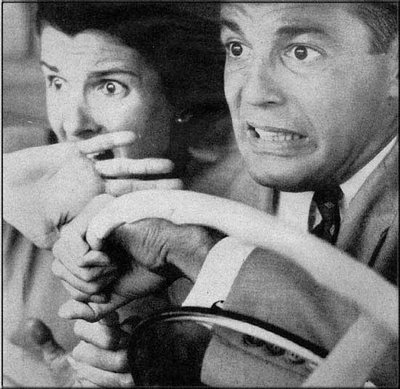4 Arguments that Make a Higher Speed Limit in Ontario a Good Idea
 What’s the fastest you’ve ever driven? Some of you may not want to admit it, because it’s the number that would make you seem a bit insane. Here in Ontario, you don’t want to push the pedal too hard, considering there are OPP officers, speed traps and even helicopters to get you. And the obvious consequence of getting caught is a speeding ticket. With that said, a lot of people think it’s time the government raises the highway speed limit in Ontario (and even all of Canada). Where do you stand? It’s a debate that doesn’t always seem to have a right or wrong answer. However, it should matter to you since these laws affect your travel time, safety and overall driving experience.
What’s the fastest you’ve ever driven? Some of you may not want to admit it, because it’s the number that would make you seem a bit insane. Here in Ontario, you don’t want to push the pedal too hard, considering there are OPP officers, speed traps and even helicopters to get you. And the obvious consequence of getting caught is a speeding ticket. With that said, a lot of people think it’s time the government raises the highway speed limit in Ontario (and even all of Canada). Where do you stand? It’s a debate that doesn’t always seem to have a right or wrong answer. However, it should matter to you since these laws affect your travel time, safety and overall driving experience.
Speed limits around the world
So the highway limit in Ontario is 100 km/h. It could be worse – it’s 90 km/h in Nunavut and Prince Edward Island. And if you were to look globally, you’d realize that there are many other countries where drivers have to move at a sluggish speed. Just take a look:
- 80 km/h limit – If you plan to drive in Bolivia, Faroe Islands, Greenland, Honduras, Lesotho, Liechtenstein, Malta, Macau, Madagascar, Montenegro, Suriname, Trinidad & Tobago or Uganda, prepare yourself for the 80 km/h maximum.
Strangely, these countries are exceptions. The majority of countries have speed limits of at least 100 km/h, many more which have a speed limit of at least 110 – 120 km/h+. So in comparison, even Canada leans more on the slower side, the exception being British Columbia which has a speed limit of 120 km/h. Drive abroad on another continent such as Europe, or in countries in South America, Africa and Asia, and you’ll probably feel like a snail during your first few moments on the road.
- 120 km/h – If you are going to visit Mexico, Brazil, Columbia, Venezuela, Chile, South Africa, Egypt, Algeria, Morocco, Portugal, Spain, Sweden, Saudi Arabia, Iran, India or China, you won’t have to check your rearview mirror when doing 120 km/h – it’s totally legal.
 You could imagine that if 120 km/h is the speed limit in these countries, you might get away with doing 130 or even 140 – speeds that would get you serious infractions here in Ontario, if an officer pulled you over. Yet still, there are countries that go beyond the 120 km/h limit. So driving like a Canadian in anyone of these places would probably provoke the wrath of the locals.
You could imagine that if 120 km/h is the speed limit in these countries, you might get away with doing 130 or even 140 – speeds that would get you serious infractions here in Ontario, if an officer pulled you over. Yet still, there are countries that go beyond the 120 km/h limit. So driving like a Canadian in anyone of these places would probably provoke the wrath of the locals.
- 130 – 140 km/h – If you really want to drive with no inhibition, then you need to hit the roads in Russia, France, Argentina, Lithuania and Ukraine for the 130 km/h road limits. And for an even higher limit of 140 km/h, visit Poland, Bulgaria or even Texas.
As you can see, there are many countries that embrace the higher speeds that our own law enforcement frowns upon. With that said, do they have some insight that we don’t? It’s fair to say that if they can allow such high speed limits, we can too.
Arguments for a Speed Limit Increase
Let’s present some arguments for you race car drivers out there. Raising the speed limit in Ontario and other provinces/territories in Canada could have benefits. And they go beyond exhilaration and thrills.
Raise the speed, lower the collisions
Yep, you read that right. As ironic as it seems, road engineers share the belief that a higher speed limit can reduce the rate of accidents that occur on highways. When the range of driving speed is too large – that is, slow and fast vehicles moving at drastically different speeds – the likelihood of collisions skyrocket. And this usually happens when speed limits are too low. In fact, when the government of B.C. raised their rural highway speeds from 90 km/h to 100 km/h, there was an 18% decline in serious collisions. So as strange as it may seem, getting drivers to pick up the pace might actually make everyone a little safer.
Maybe speed doesn’t kill…?
We’re not going to say that speed can’t be deadly. For example, a collision at 100 km/h is 16 times worse than impact at 25 km/h. But some of the fastest roadways in the world happen to be the safest. You most likely know the Autobahn, the famous roadway in Germany that has no speed limit throughout some of its sections. You’d think a roadway with no limit would be a deathtrap – it’s not the case. In fact, Germany has a death rate of 6.9 per 100,000 cars, while Canada has 13. So with that in mind, it’s fair to put the blame on other factors, such as a lack of driving skill (which tends to be better in other countries), car safety and quality (which also, tends to be better in other countries), as well as environmental conditions, such as bad weather.
Autobahn Driving
Too many drivers may be the real problem
Another reason to fight the “speed kills” mantra, is the factor of how many cars are on the road. It’s a given that a region with more cars on its freeways and highways will have more accidents. For that reason, the inhabitants of heavily populated and urban areas usually spend more on car insurance. The lack of overcrowding may have been a reason that made the Autobahn so safe, although the number of drivers using this route has increased significantly. What is known, though, is the fact that a crowded roadway often increases driver confusion. And if you’ve ever been stuck in gridlock traffic (big problem in Canadian cities), you’ve probably seen your share of fender-benders that occurred at slower speeds.Slow drivers are just as bad
People tend to look at fast drivers as the reason why roads are unsafe (along with the drunk drivers). But what about the slow ones? They too are a leading cause of accidents these days, because they’re often distracted or too indecisive when making lane changes or turns, in effect, confusing the faster drivers around them. You’ve probably seen (or had) a few close calls where drivers had to hard brake or swerve after another driver slowly turned into their lane. It’s infuriating. Although we don’t have a law against driving too slow in Ontario, you can get a ticket for doing so if an officer deems you as a danger on the road.
slow ones? They too are a leading cause of accidents these days, because they’re often distracted or too indecisive when making lane changes or turns, in effect, confusing the faster drivers around them. You’ve probably seen (or had) a few close calls where drivers had to hard brake or swerve after another driver slowly turned into their lane. It’s infuriating. Although we don’t have a law against driving too slow in Ontario, you can get a ticket for doing so if an officer deems you as a danger on the road.
A reminder of a consequences
Until the speed limit goes up in Ontario, try your best not to overdo it. There is a space of grace where officers generally won’t pull you over - the upper limit being 120 km/h - but going above that is what will land you in trouble. So go easy on the pedal. If you need a reminder of what can happen if you ignore the speed limit, look below.The price of being a speed demon in Ontario
| SPEEDING RANGE | POINTS |
| 0 – 15 kilometers |
|
| 16 – 29 kilometers over the limit |
|
| 30 – 49 kilometers over the limit |
|
| 50 kilometers over the limit |
|
| Stunt Driving – Racing – Speeding 50km/h or more |
|






